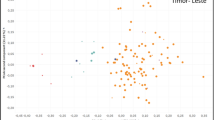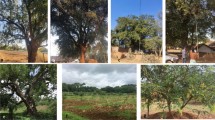Abstract
Most of the plant species from the genus Lilium L. have great ornamental and edible value. In this study, target region amplification polymorphism (TRAP) polymorphic marker technique was applied to assess the genetic relationships among 13 Lilium species/cultivars. The technique was also used to evaluate genetic diversity among two population of L. regale E. H. Wilson, cultivar of ‘Regale’ and ‘Regale Album’, and genetic diversity among two population of L. henryi Baker and cultivar of ‘Henryi’. In total, 221 fragments were amplified by 14 pairs of primers for 13 Lilium species/cultivars, of which 59 (26.70%) showed polymorphism. 1160 fragments were amplified for two population of L. regale, cultivar of ‘Regale’ and ‘Regale Album’, of which 943 (81.25%) were polymorphic. 798 fragments were amplified for two population of L. henryi and ‘Henryi’, of which 574 (71.93%) were polymorphic. A cluster analysis was performed based on UPGMA and PCoA by relying on the Nei’s genetic distance. Our results indicated that TRAP marker technique is informative and could be used to evaluate the genetic relationships among Lilium species/cultivars and genetic diversity among populations. The results will also provide more valuable information for Lilium resource protection and current plant breeding programs.






Similar content being viewed by others
References
Al Shaye N, Migdadi H, Charbaji A, Alsayegh S, Daoud S, Al-Anazi W (2018) Genetic variation among Saudi tomato (Solanum lycopersicum L.) landraces studied using SDS-PAGE and SRAP markers. Saudi J Biol Sci 25:1007–1015
Alwala S, Suman A, Arro JA, Veremis JC, Kimbeng CA (2006) Target region amplification polymorphism (TRAP) for assessing genetic diversity in sugarcane germplasm collections. Crop Sci 46(1):448
Andersson I, Backlund A (2008) Structure and function of RuBisCO. Plant Physiol Biochem 46(3):275–291
Badfar-Chaleshtori S, Shiran B, Kohgard M, Mommeni H, Hafizi A, Khodambashi M et al. (2012) Assessment of genetic diversity and structure of imperial crown (fritillaria imperialis l.) populations in the zagros region of iran using aflp, issr and rapd markers and implications for its conservation. Biochem Syst Ecol 42:35–48
Barbosa DA, Silva GW, Sílvia Nietsche, Toledo PMC, Alves RBR, Borges FL (2018) Genetic diversity between and within full-sib families of Jatropha using ISSR markers. Ind Crop Prod 124:899–905
Baruah J, Pandey SK, Begum T, Sarma N, Paw M, Lal M (2019) Molecular diversity assessed amongst high dry rhizome recovery ginger germplasm (Zingiber officinale, Roscoe) from NE-India using RAPD and ISSR markers. Ind Crop Prod 129:463–471
Bussell JD (1999) The distribution of random amplified polymorphic DNA (RAPD) diversity amongst populations of Isotoma petraea (Lobeliaceae). Mol Ecol 8(5):775–789
Deepa P, Marshall GB, Davies KM, Lewis DH, Boase MR, Schwinn KE (2010) Isolation and antisense suppression of flavonoid 3′,5′-hydroxylase modifies flower pigments and colour in cyclamen. BMC Plant Biol 10(1):1–12
Du YP, He HB, Wang ZX, Wei C, Li S, Jia GX (2014a) Investigation and evaluation of the genus Lilium resources native to china. Genet Resour Crop Evol 61(2):395–412
Du YP, He HB, Wang ZX, Li S, Wei C, Yuan XN (2014b) Molecular phylogeny and genetic variation in the genus Lilium native to china based on the internal transcribed spacer sequences of nuclear ribosomal DNA. J Plant Res 127(2):249–263
Du F, Wu Y, Zhang L, Li XW, Zhao XY, Wang WH, Gao ZS, Xia YP (2015) De Novo assembled transcriptome analysis and SSR marker development of a mixture of six tissues from Lilium oriental hybrid ‘Sorbonne’. Plant Mol Biol Rep 33(2):281–293
Du YP, Bi Y, Yang FP, Zhang MF, Chen XQ, Xue J, Zhang XH (2017) Complete chloroplast genome sequences of Lilium: insights into evolutionary dynamics and phylogenetic analyses. Sci Rep UK 7(1):1–10
Facchini PJ, Johnson AG, Luca PVD (1996) Uncoupled defense gene expression and antimicrobial alkaloid accumulation in elicited opium poppy cell cultures. Plant Physiol 111(3):687–697
Feng S, He R, Yang S, Chen Z, Jiang M, Lu J (2015) Start codon targeted (SCoT) and target region amplification polymorphism (TRAP) for evaluating the genetic relationship of Dendrobium species. Gene 567(2):182–188
Han Y, Vimolmangkang S, Soria-Guerra RE, Rosales-Mendoza S, Zheng D, Lygin AV, Korban SS (2010) Ectopic expression of apple F3′H genes contributes to anthocyanin accumulation in the Arabidopsis tt7 mutant grown under nitrogen stress. Plant Physiol 153(2):806–820
Hayashi K, Kawano S (2000) Molecular systematics of Lilium and allied genera (Liliaceae): phylogenetic relationships among Lilium and related genera based on the rbcL and matK gene sequence data. Plant Spec Biol 15(1):73–93
Hong XX, Luo JG, Guo C, Kong LY (2012) New steroidal saponins from the bulbs of L. brownii var. viridulum. Carbohydr Res 361:19–26
Hu J, Vick B (2003) Target region amplification polymorphism: a novel marker technique for plant genotyping. Plant Mol Biol Rep 21:289–294
Hu J, Mou B, Vick BA (2007) Genetic diversity of 38 spinach (Spinacia oleracea L.) germplasm accessions and 10 commercial hybrids assessed by TRAP markers. Genet Resour Crop Evol 54(8):1667–1674
Hutchison DW, Templeton AR (1999) Correlation of pairwise genetic and geographic distance measures: inferring the relative influences of gene flow and drift on the distribution of genetic variability. Evolution 53:1898–1914
Jatin K, Monika H, Kuldeep S, Veena A (2019) SRAP and SSR marker-assisted genetic diversity, population structure analysis and sex identification in Jojoba (Simmondsia chinensis). Ind Crop Prod 133:118–132
Kawano Y, Sekine M, Ihara M (2014) Identification and characterization of UDP-glucose pyrophosphorylase in cyanobacteria Anabaena sp. pcc 7120. J Biosci Bioeng 117(5):531–538
Kleczkowski L, Kunz S, Wilczynska M (2010) Mechanisms of UDP-glucose synthesis in plants. Crit Rev Plant Sci 29(4):191–203
Li G, Quiros CF (2001) Sequence-related amplified polymorphism (SRAP), a new marker system based on a simple PCR reaction: its application to mapping and gene tagging in Brassica. Theor Appl Genet 103:455–461
Liang SY, Tamura M (2000) In: Wu ZY, Raven PH (eds) Flora of China, vol 24. Science Press/Missouri Botanical Garden Press, Beijing/St. Louis, pp 118–152
Luo C, Zhang F, Zhang QL, Guo DY, Luo ZR (2013) Characterization and comparison of EST-SSR and TRAP markers for genetic analysis of the Japanese persimmon Diospyros kaki. Genet Mol Res 12(3):2841–2851
McRae EA (1998) Lily species. Lilies. Timber Press, Portland, pp 105–204
Millar DJ, Long M, Donovan G, Fraser PD, Boudet AM, Danoun S (2007) Introduction of sense constructs of cinnamate 4-hydroxylase (CYP73A24) in transgenic tomato plants shows opposite effects on flux into stem lignin and fruit flavonoids. Phytochemistry (Amsterdam) 68(11):1497–1509
Mimaki Y, Sashida Y, Nakamura O, Nikaido T, Ohmoto T (1993) Steroidal saponins from the bulbs of L. regale and L. henryi. Phytochemistry 33:675–682
Munafo JP Jr, Gianfagna TJ (2015) Chemistry and biological activity of steroidal glycosides from the Lilium genus. Nat Prod Rep 32(3):454–477
Nishikawa T (2007) Molecular phylogeny of the genus Lilium and its methodical application to other taxon Thesis United Graduate School of Agricultural Science. Tokyo University of Agriculture and Technology
Nishikawa T, Okazaki K, Nagamine T (2002) Phylogenetic relationships among L. auratum Lindley, L. auratum var. platyphyllum Baker and L. rubellum Baker based on three spacer regions in chloroplast DNA. Breed Sci 52:207–213
Peng X, Ji Q, Fan S, Zhang Y, Zhang J (2015) Genetic diversity in populations of the endangered medicinal plant Tetrastigma hemsleyanum revealed by ISSR and SRAP markers: implications for conservation. Genet Resour Crop Evol 62(7):1069–1078
Pelkonen VP, Pirttil AM (2012) Taxonomy and phylogeny of the genus lilium. Floriculture Ornamental Biotechnol 6:1–8
Treuren RV, Hintum TJLV (2009) Comparison of anonymous and targeted molecular markers for the estimation of genetic diversity in ex situ conserved Lactuca. Theor Appl Genet 119(7):1265–1279
Yamagishi M (2013) How genes paint lily flowers: regulation of colouration and pigmentation patterning. Sci Hortic Amst 163:27–36
Yuan S, Ge L, Liu C, Ming J (2013) The development of EST-SSR markers in L regale and their cross-amplification in related species. Euphytica 189(3):393–419
Zhang JY, Guo QS, Zheng DS (2013) Genetic diversity analysis of Pinellia ternata based on SRAP and TRAP markers. Biochem Syst Ecol 50:258–265
Zhao B, Zhang J, Guo X, Wang J (2013) Microwave-assisted extraction, chemical characterization of polysaccharides from L. davidii var. unicolor Salisb and its antioxidant activities evaluation. Food Hydrocolloids 31(2):346–356
Zhao J, Li T, Xu Z, Wang Z, Chen A (2018) AFLP markers for meat traceability of cattle in the Chinese market. Food Control 91:421–426
Acknowledgments
This work was supported by the National Natural Science Foundation of China (Grant No. 31601781) and Youth Research Fund of Beijing Academy of Agriculture and Forestry (QNJJ201910).
Author information
Authors and Affiliations
Corresponding authors
Additional information
Publisher's Note
Springer Nature remains neutral with regard to jurisdictional claims in published maps and institutional affiliations.
Electronic supplementary material
Below is the link to the electronic supplementary material.
Rights and permissions
About this article
Cite this article
Hu, Y., Ren, J., Liu, Y. et al. Evaluating the genetic relationship of Lilium species/cultivars based on target region amplification polymorphism (TRAP). Genet Resour Crop Evol 67, 503–513 (2020). https://doi.org/10.1007/s10722-019-00880-9
Received:
Accepted:
Published:
Issue Date:
DOI: https://doi.org/10.1007/s10722-019-00880-9




